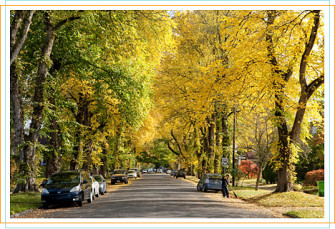What Makes a Neighborhood Great?
 What distinguishes a great neighborhood from the merely so-so? It’s a difficult question, encompassing everything from physical attributes such as good design to the right number of parks and public gathering places. Is it a charming Main Street, good schools or an abundance of interesting shops, restaurants and other diversions? Elements that encourage interaction – parks, boardwalks, public plazas and wide sidewalks – serve as people magnets. Best of all are sidewalks on a community’s main street that run between café seating and storefront window displays, allowing people to walk dogs, greet neighbors and people watch. Add things such as weekly farmers markets, civic-association pancake breakfasts and multidimensional establishments that offer opportunities to linger, such as a coffee shop with art displays, a lively bulletin board and outdoor café seating, and you’ve got the beginnings of a great neighborhood hub.
What distinguishes a great neighborhood from the merely so-so? It’s a difficult question, encompassing everything from physical attributes such as good design to the right number of parks and public gathering places. Is it a charming Main Street, good schools or an abundance of interesting shops, restaurants and other diversions? Elements that encourage interaction – parks, boardwalks, public plazas and wide sidewalks – serve as people magnets. Best of all are sidewalks on a community’s main street that run between café seating and storefront window displays, allowing people to walk dogs, greet neighbors and people watch. Add things such as weekly farmers markets, civic-association pancake breakfasts and multidimensional establishments that offer opportunities to linger, such as a coffee shop with art displays, a lively bulletin board and outdoor café seating, and you’ve got the beginnings of a great neighborhood hub.
Location, Location, Location
Of course, few people are going to settle in a neighborhood if it doesn’t have access to well-paying jobs. The places that have the most value and that gentrified first were those closest to, or have access to, high-paying jobs. A study released earlier this year by the American Public Transportation Association and the National Association of Realtors showed that between 2006 and 2012, home values performed 42% better on average if the homes were within a half-mile of public transportation with high-frequency service, such as subway, light rail or bus rapid transit. Residents in those areas had better access to jobs and lower transportation costs, leaving them with more money to enjoy neighborhood amenities. Another perk: Transit stations often attract retail shops, services and dining, giving some suburbs without a real downtown a place to walk and linger.
Education, Education, Education
By and large, the highest-value home prices in America are found in school districts of very high quality. These areas, such as the Washington D.C. commuter suburbs of Vienna/Oakton and Rockville/Bethesda, are the blue-chip stocks of neighborhoods, even for people without kids, because they attract people with higher levels of education, who tend to be more active in preserving community value.
Walkability and Convenience
A neighborhood will draw people if it’s providing the opportunity for interaction with a backdrop of design that is enjoyable to look at.
- Short blocks with relatively narrow streets and wide sidewalks.
- Ample windows at eye level that let you see activity or displays inside as well as entryways, courtyards and arcades.
- Human-scale lighting, benches and signs.
- Tree-lined streets that provide a sense of buffer from street traffic and a comfortable canopy overhead.
- Landmarks such as fountains, historic theaters, gazebos or clock towers.
- A complexity of architecture, building materials and color — at least on the first couple of building levels — as well as a mix of building uses.
Interaction is key to people’s satisfaction with their communities. If people are happy and engaged with their community, they are more involved with its activities and work harder to protect it. A great neighborhood usually evolves organically with its residents and is master-planned with mixed retail and residential developments. In these areas, complementary design, rich amenities and public spaces encourage engagement among residents and visitors with places to stroll, eat and play. It helps if the mix of amenities and activities is attractive to younger and older generations alike.
Many of the best neighborhoods are yet to come, as cities encourage more creative development in urban areas. Planners expect that two-thirds of the development on the ground in 2050 will be built between now and then. Indeed, some of tomorrow’s popular neighborhoods will likely spring from former blight. Communities can go from being the hero to the zero to the hero all over again.
